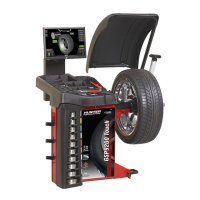INTRODUCTION TO BALANCING 11
2.1 Balance Forces
Balancing Theory - Static Imbalance
As the word static implies, the tire will be balanced
when at rest. For example, if an unmoving assembly
was centered on a cone and was balanced, it would be
statically balanced. A “bubble balancer” is designed to
statically balance a tire/wheel assembly.
STATIC
FORCE
LIMIT
STATIC FORCE
GRAPH DISPLAY
STATIC
FORCE
Figure 19.
CUPPING
Figure 20.
Static imbalance is a condition where one amount of
weight located in the center of the tire/wheel assembly
causing an imbalance. As the weight rotates, centrifugal
forces are created causing the wheel to lift as the weight
reaches top dead center. This lifting motion causes the
tire/wheel assembly to move “up and down” creating a
bounce that can be felt. This static imbalance condition is
evident by a “jiggle” or up-down movement of the steering
wheel. These vibrations may also be apparent in the
body, with or without steering wheel shake.
2. Introduction to
Balancing

